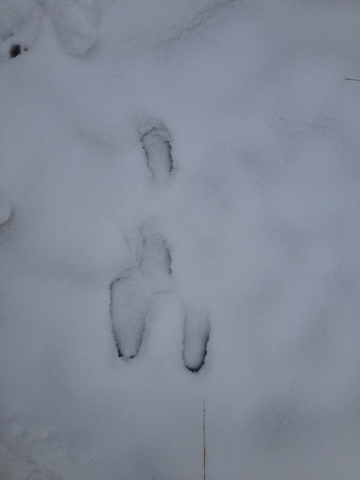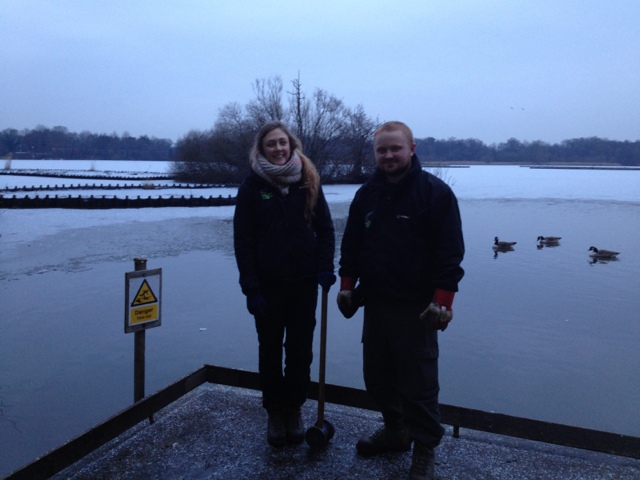There is a great video explaining the Fleet Pond Restoration Project on You Tube filmed by the Environment Agency. It shows great close ups of the new islands and explains the project really well!
https://www.youtube.com/watch?v=r7HxaQSqloc
Tuesday 22 January 2013
Sunday 20 January 2013
Tracks and signs
When it snows it is great to see all the tracks and signs left by visitors. Such as dogs, foxes, deer, rabbits, moorhens, water rail, blackbirds and sledges
Saturday 19 January 2013
Thursday 17 January 2013
Danger thin ice!
Today we popped the thin ice signs out around Fleet Pond as the cold weather has started to set in. Please do not go out onto the ice it is dangerous! The restoration project dredging has significantly deepened some areas which will cause thin patches!
Thank you
Hopefully see you around the Pond
Louise Greenwood
Fleet pond countryside ranger
Thank you
Hopefully see you around the Pond
Louise Greenwood
Fleet pond countryside ranger
Odiham Common Coppicing
This week we've been coppicing the hazel at Odiham Common. We cut the hazel on a rotation so there are stands of lots of different ages. The various ages of hazel is really important in maintaining a rich biodiversity with the freshly cut hazel allowing light in which is great for wild flowers and nectar feeding insects. The more shaded older hazel is great for hazel dormice. The hazel grows really straight so we cut the stems up into lengths and we will use some of them to lay the hedge at Fleet Pond next to Fugelmere Marsh
Monday 7 January 2013
Fleet Pond Customer Needs Consultation
The Fleet Pond Customer Needs Report has been brought together by the steering group of the Environment Agency, Fleet Pond Society, Hart District Council, and Natural England.
We want you to tell us what would make your visit to Fleet Pond more enjoyable and encourage those who have not yet visited the pond to enjoy their visit and wish to return. This is your opportunity to tell us what you like about Fleet Pond and suggest how it might be improved.
To date the steering group has engaged an independent researcher and the resulting documents are available for consultation from 7th December at:
We will be available to answer any questions on Friday 11th and Saturday 12th January 9am - 5pm at Hart Leisure Centre, Hitches Lane, Fleet GU51 5HS.
You can respond to the consultation process by emailing:
countryside@hart.gov.uk
or alternatively you can post your responses to:
Fleet Pond Visitor Strategy Consultation
Leisure and Environmental Promotion
Civic Offices, Fleet
Hampshire, GU51 4AE
Phoenix Greens Veterans get Room to Breath
Phoenix Green is home to a wealth of wildlife. It is classified as a Site of Importance for Nature Conservation (SINC). Its fantastic veteran Oak trees make it a haven for birds, bats and invertebrates.
In the past Phoenix Green would have been a woodland pasture, its Oak trees growing in open conditions with an understory of Hazel. In these conditions with plenty of light the trees can grow uninhibited to a ripe old age, spreading their branches wide.
However over time, due to a lack of traditional woodland management such as coppicing and grazing, dense secondary woodland has grown up around the veteran trees. This competition from younger, more vigorous trees means the veterans have become engulfed by Birch, Sycamore, Holly, Hornbeam and younger Oaks.
Oak is a light demanding species. When they grow in dense woodland the trees become over-crowded. They grow very tall with thin trunks due to the competition for light with their neighbours. This is bad news for the life span of individual trees. Trees die young in dense woodlands, individuals not surviving to reach old age. It is the aging veteran trees that have developed in open-grown situations that are the richest for biodiversity.
The problems begin when younger trees begin to grow up through and/or over the top of the veterans and shade their canopy. In Phoenix Green the Holly can be particularly detrimental, as being shade tolerant they can grow very close to the trunk of the veteran and compete for water in dry years. They are also serious
competitors for light when tall. So how can we solve this problem and conserve our veteran Oaks for the future?
A woodland management process called ‘haloing’ has been advocated as a good way to preserve the life of the veteran tree. This involves removing the individual younger trees from around and under the veterans which are in direct contact with the veteran’s crown or lower limbs, and so releasing the tree from competition. In the New Year we will be doing exactly this in a trial area near Dilly Lane.
It is very important to help conserve and protect Phoenix Greens veteran Oak trees as they are so valuable to the biodiversity and conservation of the area. They can support many specialist species of invertebrates and fungi, especially in their decaying wood. The presence of cavities often found in these older trees provide
suitable habitat for nesting birds as well as roosting bats.
Veteran trees are fantastic features in any woodland, and by haloing these grand old Oaks we hope to retain them for future generations to enjoy and admire.
Subscribe to:
Posts (Atom)













